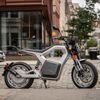LINKS OF THE WEEK: Feb 12, 2024
Interesting stats on EVs and energy use in the US, developments in wind and tidal power, a plastic recycling microfactory, and an "unprecedented collapse" in EU fossil fuel generation.
We are in the early(ish) stages of a major evolution in transportation – and micromobility will likely play a major role in it.

My intelligent, ambitious, over-achieving 18-year-old doesn’t know how to drive.
I find this somewhat confounding.
When I was his age, learning how to drive was a rite of passage. Cars weren’t just vehicles. They were freedom. Independence. Status. By my 18th birthday, I had been driving for almost two years. My car – a 1980 red Ford Pinto (with white Starsky and Hutch stripes!) that I had saved for months to buy – was my most valued possession. It empowered me to go wherever I wanted without having to rely on my parents or let them know exactly where I’d been. And it gave me a private place where I could play loud music and furtively smoke menthol cigarettes while driving along country roads and trying to figure out who the heck I was and what I wanted in life.
So the fact that my keener kid has shown so little interest in getting his driver’s licence was surprising and even a bit troubling to me.
Why was he so ambivalent about learning how to drive? Didn’t he want to stretch his wings and grow his independence? Was it because he spent too much time in his room playing video games? Had fear of climate change killed his desire to grow up and “become an adult”? Did he not realize he might find it more challenging to win the respect of others if he couldn’t display the independence and control over one’s destiny that a driver’s licence represents?
(Parents can stress over the silliest things that tell you way more about THEM than the kids they’re worried about.)
Then one day, earlier this spring, when I asked my son yet again why, after getting his learner’s permit, he hadn’t made any effort to practice his driving, he looked at me with obvious exasperation and said, “Mom! It’s not a priority right now. Besides, I don’t need to drive a car when I’ve got my ebike.”
That stopped me short.
Because he was right. In our small town on the southern coast of British Columbia, his ebike takes him wherever he wants to go – to school, work, his friend’s houses or the beach. He saved for months to buy that bike and he loves it like I loved my Pinto. He rides it everywhere – even when the weather isn’t great – because it’s convenient and fun and doesn’t require him to pay through the nose for insurance, fuel, and maintenance.
Because of his ebike, he has a decent chunk of money saved up for university.
(And did I mention it’s fun?)
This has led me to believe two things…
ONE: Generation Z, with their pragmatism and problem-solving skills, will likely save us all.
TWO: We are in the early stages of a massive transformation of how we move ourselves and our stuff from place to place. And micromobility will likely play a major role in it.
It’s basically a fancy catch-all term to describe all the forms of e-transportation that are smaller than a typical car.
This includes ebikes, e-scooters (of both the “stand-on-a-board” & “I wanna be a motorcycle when I grow up” varieties), one-wheels, unicycles, tricycles, electric rickshaws, and more. These small one- or two-person electric vehicles are surging in popularity all over the world and could play a vital role in our transportation infrastructure of the future.
Here are just a few reasons why micromobility could transform transportation as we know it:
These are just a few of the reasons why micromobility has the potential to play a significant role in our future transportation landscape.
Of course, we’re not even close to creating that future yet!
Many people still have a lot of resistance around the idea of giving up their large vehicles in favour of smaller, more agile options – especially here in North America, where so much of our infrastructure was built for cars, and so much of our economy and our politics are dominated by fossil fuel interests. I suspect we’ll make slower progress than countries in other parts of the world, particularly in Asia and Europe, where rates of micromobility adoption have been climbing rapidly in recent years.
And it’s always possible that other transportation options will rise in prominence, eliminating the need for micromobility in many cases. Who knows? Maybe Elon Musk’s vision of self-driving cars will come true and everyone will eventually subscribe to their favourite car-sharing service that will send autonomous vehicles to their doorstep to take them wherever they want to go, so personal vehicles in general fall out of fashion.
OR maybe the “15-minute cities are a GLOBALIST CONSPIRACY!” folks will rebel so violently against the idea of making any sort of car travel more difficult in any way, that efforts to make the world more bikeable or reduce the number of environmentally destructive cars on the road will fail miserably.
Only time will tell!
However our journey rolls out, we’re likely in for an interesting (and sometimes bumpy) ride over the next couple of decades as the transportation sector weans itself off fossil fuels and evolves in response to our changing social and environmental circumstances.
In the meantime, I think I’ll take my ebike and ride it up a very steep hill, very fast.
Just because I can.
And because it’s fun.
(Still want my kid to get his driver’s licence, though. Because, you know. Parents worry about the silliest things.)
_________
** If you’re interested in learning more about latest developments in micromobility, be sure to sign up for the Micromobility Newsletter – they offer a ton of great info!